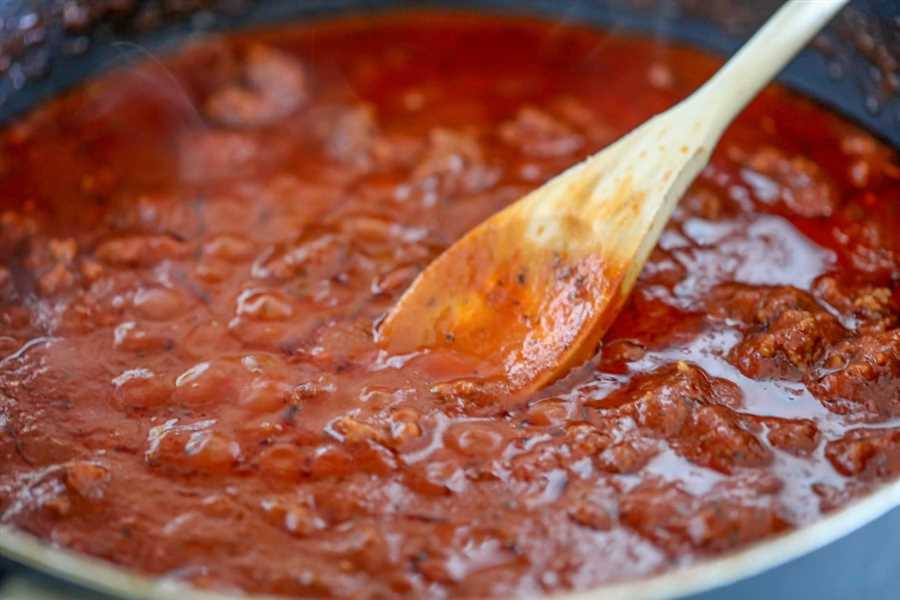



Have you ever wondered if you can cook pasta directly in the sauce?
Many people believe that cooking pasta separately and then adding the sauce is the only way to achieve the perfect pasta dish. However, some culinary experts argue that you can indeed cook pasta in the sauce, saving time and creating a unique flavour.
One popular method is known as the “one-pot pasta” or “pasta in the sauce” technique.
Instead of boiling pasta in a large pot of water, you cook it directly in the sauce, allowing the pasta to absorb the flavors of the sauce as it cooks.
This method requires less water and fewer dishes, making it a convenient option for those who want a quick and easy meal. Additionally, cooking the pasta in the sauce can give it a thicker, more creamy texture.
However, it’s important to note that this method may not work well with all types of pasta. Pasta shapes that are more delicate or require a longer cooking time may not fare well when cooked in the sauce. It’s best to stick with sturdy pasta shapes like penne or rigatoni, which can hold up to the cooking process.
Is it possible to cook pasta directly in the sauce?
One popular cooking method is to cook pasta separately and then combine it with the sauce. However, some people wonder if it is possible to cook pasta directly in the sauce. This method can save time and effort, as it eliminates the need for boiling water and draining the pasta. Let’s take a closer look at this technique and whether it is effective.
Advantages of cooking pasta in the sauce:
There are several advantages to cooking pasta directly in the sauce. First, it can enhance the flavor of the pasta, as it absorbs the flavors from the sauce while cooking. This can result in a more flavorful and cohesive dish. Second, it can save time and energy, as you eliminate the need for a separate pot to boil water and cook the pasta. Lastly, cooking pasta in the sauce can create a creamier texture, as the pasta releases starches into the sauce as it cooks.
Steps to cook pasta in the sauce:

To cook pasta directly in the sauce, follow these steps:
- Heat a large pan or skillet over medium heat.
- Add the sauce ingredients, such as tomatoes, herbs, and spices, to the pan and cook until the flavors meld together.
- Add the uncooked pasta to the pan, ensuring it is fully submerged in the sauce.
- Add enough liquid, such as water or broth, to cover the pasta.
- Bring the mixture to a simmer and cook until the pasta is al dente, stirring occasionally to prevent sticking.
- Once the pasta is cooked to your desired consistency, remove the pan from the heat and let it rest for a few minutes.
- The pasta will continue to absorb the sauce and thicken as it rests.
- Serve the pasta directly from the pan, garnish with cheese or herbs if desired, and enjoy!
Considerations and potential challenges:
While cooking pasta directly in the sauce can be a convenient method, there are a few considerations and potential challenges to keep in mind. First, using the right amount of liquid is crucial to ensure the pasta cooks evenly and does not become too dry. You may need to add more liquid during the cooking process if needed.
Second, different types of pasta may require different cooking times and liquid ratios. It is important to adjust the cooking time and liquid amount based on the type of pasta you are using. Thicker pasta, such as penne or rigatoni, may require more liquid and longer cooking times, while thinner pasta, like angel hair or spaghetti, may cook faster.
Lastly, keep in mind that cooking pasta directly in the sauce may result in a slightly different texture compared to traditional methods. The pasta can be more flavorful but may also be softer and stickier. It is a matter of personal preference.
| Advantages | Steps to cook pasta in the sauce | Considerations and potential challenges |
|---|---|---|
|
|
|
Benefits of cooking pasta in the sauce
When it comes to cooking pasta, there are many different methods and techniques to choose from. One popular method is cooking pasta directly in the sauce, which offers several benefits. Here are some of the advantages of this cooking method:
|
Enhanced flavor: Cooking pasta in the sauce allows the noodles to absorb the flavors from the sauce, resulting in a more flavorful dish. The pasta becomes infused with the rich taste of the sauce, creating a harmonious blend of flavors. |
Better texture: Cooking pasta in the sauce helps the noodles to achieve a perfect texture. The sauce helps to soften the pasta, making it tender and delicious. The starch released from the pasta during cooking also helps to thicken the sauce, creating a velvety and creamy consistency. |
|
Time-saving: Cooking pasta in the sauce saves time and reduces the number of pots and pans needed for cooking. By cooking the pasta and sauce together, you eliminate the need for a separate pot to cook the pasta and then another to heat the sauce. This method streamlines the cooking process and makes cleanup easier. |
Improved absorption: When pasta is cooked in the sauce, it has the ability to absorb the flavors of the sauce more efficiently. This means that with each bite, you get a burst of delicious sauce along with the pasta. The noodles act as sponges, soaking up the savory flavors and enhancing the overall taste of the dish. |
Overall, cooking pasta in the sauce is a convenient and delicious way to prepare this classic dish. Whether you’re making a simple marinara sauce or a rich and creamy Alfredo sauce, cooking the pasta directly in the sauce ensures that each bite is packed with flavor. Give it a try and elevate your pasta dishes to a whole new level of taste!
How to cook pasta in the sauce
One delicious and convenient way to cook pasta is by cooking it directly in the sauce. This method allows the pasta to absorb the flavors of the sauce, resulting in a more flavorful and cohesive dish. Here’s how you can do it:
- Choose a suitable sauce: Not all sauces are suitable for cooking pasta in. Opt for thicker sauces like marinara, bolognese, or Alfredo that will coat the pasta properly.
- Prepare the sauce: Start by making the sauce in a wide and deep pan. Allow it to simmer for a while so that the flavors meld together.
- Add the pasta: Once the sauce is simmering, add the uncooked pasta directly into the pan. Make sure that the pasta is submerged in the sauce as much as possible.
- Cook the pasta: Stir the pasta occasionally to prevent it from sticking together. Cook the pasta in the sauce according to the package instructions or until it reaches your desired level of tenderness. This typically takes about 8-12 minutes.
- Adjust the consistency: If the sauce becomes too thick while cooking the pasta, you can add a small amount of pasta cooking water to thin it out.
- Finish the dish: Once the pasta is cooked to your liking, you can add any additional ingredients like cheese, herbs, or vegetables to enhance the flavor.
- Serve and enjoy: Serve the pasta directly from the pan, making sure to get an even distribution of sauce and pasta in each serving. Garnish with fresh herbs or grated cheese if desired.
By following these steps, you can easily cook pasta in the sauce, resulting in a delicious and flavorful dish that is sure to impress your family and friends.
Best types of pasta for cooking in the sauce

When cooking pasta in the sauce, some types of pasta work better than others. The best types of pasta for cooking in the sauce are those that can hold up to the cooking process without becoming mushy or falling apart. Here are a few recommendations:
- Spaghetti: Spaghetti is a classic choice for cooking in the sauce. Its long, thin shape allows it to absorb the flavors of the sauce while staying al dente.
- Penne: Penne is another great option for cooking in the sauce. The ridged surface of penne helps hold onto the sauce, ensuring that each bite is flavorful.
- Farfalle: Farfalle, also known as bowtie pasta, is a fun and versatile choice for cooking in the sauce. Its unique shape helps it grab onto the sauce, making each bite delicious.
- Fusilli: Fusilli is a spiral-shaped pasta that is perfect for cooking in the sauce. Its twists and turns allow it to hold onto the sauce and give it a unique texture.
- Rotini: Rotini, similar to fusilli, is another spiral-shaped pasta that is great for cooking in the sauce. Its shape makes it perfect for pairing with chunky sauces.
- Macaroni: Macaroni is a popular choice for dishes like mac and cheese, but it can also be cooked in the sauce. Its small size and hollow shape make it perfect for holding onto the sauce.
Remember to cook the pasta until it is al dente before adding it to the sauce. This will ensure that it remains firm and doesn’t get overcooked during the cooking process.
Questions and answers
Can you cook pasta in the sauce?
Yes, you can cook pasta in the sauce. It is a popular Italian method known as “one-pot pasta”. The pasta is cooked along with the sauce, allowing the pasta to absorb the flavors of the sauce as it cooks.
What is the benefit of cooking pasta in the sauce?
The benefit of cooking pasta in the sauce is that it allows the flavors of the sauce to penetrate the pasta, creating a delicious and well-cooked dish. It also saves time and reduces the number of dishes to clean.
How do you cook pasta in the sauce?
To cook pasta in the sauce, simply add uncooked pasta to the sauce and enough liquid (such as water or broth) to fully cook the pasta. Bring the mixture to a boil, then reduce the heat and simmer until the pasta is cooked. Stir occasionally to prevent sticking.
What types of pasta work best for cooking in the sauce?
Most types of pasta can be cooked in the sauce, but smaller shapes like penne, fusilli, or farfalle tend to work best. These shapes cook quickly and have plenty of surface area to absorb the flavors of the sauce.









